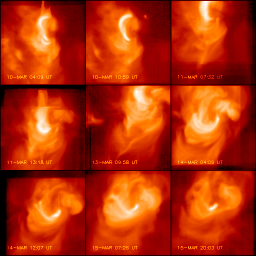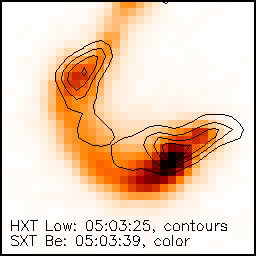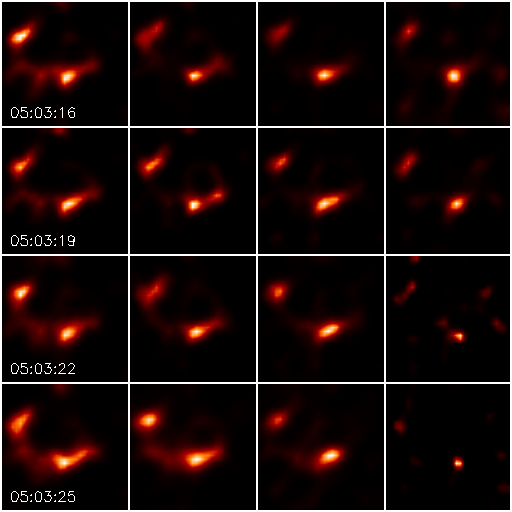
(click on this image for a full-size version)

(click on this image for a full-size version)
What is causing the loops to flicker on and off? Is it the same process which drives the flares?
For example, the comparison on the left of the HXT Lo Channel and the SXT Be channel in the flare on March 13th (C6.8) below show how these wavelengths line up, while the mosaic on the right shows how the HXT emission in the higher channels lines up (each row is a single time interval, and the 4 columns are Lo, M1, M2 and Hi). It's all happening in those two bright blobs (note, the whole field of view is about 70,000km x 70,000km),

 .
.
A TRACE 1600 A movie of the event is available here
The flare on March 15th was larger (M1.4), but still occurred entirely within a small SXT loop. However, within the loop there is a lot of activity. The brighest pixels in HXT Lo channel images move around, as can be seen in this movie (which shows HXT Lo channel on the left and SXT Be on the right). The TRACE 1600 movie also shows bright blobs moving around a loop, though of course TRACE sees a loop which looks very much more complicated than that seen by SXT. Perhaps this is the clue - there is enough structure and complexity in the magnetic field at a small scale to cause a flare, or loop brightenings, and this all happens in isolation from the overall field of the active region.
The image below on the left shows the TRACE 1600A emission at several times overlaid with contours of HXT Lo channel emission, coincident in time to within half a second (apologies for the quality of the TRACE images - couldn't quite work out how to deal with the saturated pixels!). On the right is the light curve of the 1600A emission, compared with the HXT emission in the three lower energy channels.
Hmmm. Perhaps one could convince oneself that the brightest TRACE 1600A
emission comes from near the brightest HXT emission, and that a couple
of the spikes in the HXT channels line up with small bumps in the 1600A
channels? It is hard to say. Previous studies of UV and X-ray emission
in flares had indicated that they might both be a result of the same process
of bombardment of the atmosphere by high energy particle beams, but this
set of observations may caution against hanging onto such preconceptions.
March 18, 2000
L. Fletcher (fletcher@sag.lmsal.com)
H.Hudson (hudson@isass0.solar.isas.ac.jp)